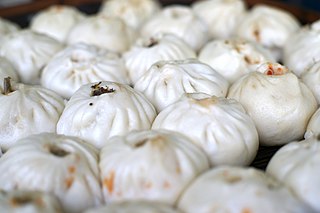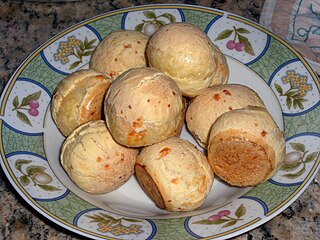The topic of this article may not meet Wikipedia's general notability guideline .(October 2023) |

Pan felipe or French roll refers to various baguette-like bread rolls in different regions around the world.
The topic of this article may not meet Wikipedia's general notability guideline .(October 2023) |

Pan felipe or French roll refers to various baguette-like bread rolls in different regions around the world.
In Hong Kong and Macau, dyun faat baau (短法包, literally "short French bread" or "short baguette"), also known as the zyu zai baau (豬仔包, "piggy bun"), is used to make pork chop buns. [1]
On the Spanish island of Mallorca, the llonguet is also known as panet francès, meaning "small French bread" or "French bread roll" in Catalan.
Carcaça and papo-seco are two traditional Portuguese breads.[ citation needed ]
Across Latin America, the terms pan francés (Spanish) or pão francês (Portuguese), both meaning "French bread", refer to various baguette-like bread rolls made with wheat flour, salt, water and yeast.
In Argentina, Paraguay, and Uruguay, pan felipe (Felipe bread) is a commonly eaten French bread roll.
In Uruguay, there's a denser version known as pan marsellés (Marseilles bread). The Marseille bread called pan marsellés in Uruguay is different from the Brazilian pão francês. The Brazilian type is less dense and lighter and crispier. However the Uruguayan version is made with a denser bread dough resulting in a harder bread (similar to Italian bread), with the crust covered in maize flour before baking.
In Bolivia and Chile, the beloved marraqueta is sometimes called pan francés. In Peru, the term pan francés (or sometimes called pan francés peruano) is different from the marraqueta. [2]
The most popular bread in Brazil is the light and crispy pão francês. Pão francês is known by several names throughout Brazil, such as cacetinho, pãozinho (little bread), pão de trigo (wheat bread), pão de água (water bread), pão aguado (watery bread), careca, and pão Jacó (Jacó bread). It is commonly found in delis and bakeries throughout Brazil. [3] [4]
In the region of Comarca Lagunera in northeastern Mexico, pan francés (or sometimes called pan francés lagunero) is an important part of daily dining. [5]
In other parts of Mexico and Central America, the word pan francés is used to refer to bolillo .

A baguette is a long, thin type of bread of French origin that is commonly made from basic lean dough. It is distinguishable by its length and crisp crust.

Latin American cuisine is the typical foods, beverages, and cooking styles common to many of the countries and cultures in Latin America. Latin America is a highly racially, ethnically, and geographically diverse with varying cuisines. Some items typical of Latin American cuisine include maize-based dishes arepas, empanadas, pupusas, tacos, tamales, tortillas and various salsas and other condiments. Sofrito, a culinary term that originally referred to a specific combination of sautéed or braised aromatics, exists in Latin American cuisine. It refers to a sauce of tomatoes, roasted bell peppers, garlic, onions and herbs. Rice, corn, pasta, bread, plantain, potato, yucca, and beans are also staples in Latin American cuisine.

The milanesa is a variation of the Lombard veal Milanese, or the Austrian Wiener Schnitzel, where generic types of breaded cutlet preparations are known as a milanesa.

Baozi, or simply bao, is a type of yeast-leavened filled bun in various Chinese cuisines. There are many variations in fillings and preparations, though the buns are most often steamed. They are a variation of mantou from Northern China.

Torta is a culinary term that can, depending on the cuisine, refer to cakes, pies, flatbreads, sandwiches, or omelettes.

Pão de queijo or Brazilian cheese bread is a small, baked cheese roll or cheese bun, a popular snack and breakfast food in Brazil. It is a traditional Brazilian recipe, originating in the state of Minas Gerais.

Pandesal is a staple bread roll in the Philippines commonly eaten for breakfast. It is made of flour, yeast, sugar, oil, and salt.

In French cuisine, fougasse is a type of bread typically associated with Provence but found in other regions. Some versions are sculpted or slashed into a pattern resembling a head of wheat.

A bolillo or pan francés is a type of savory bread made in Mexico and Central America. It is a variation of the baguette, but shorter in length and is often baked in a stone oven. Brought to Mexico City in the 1860s by Emperor Maximilian's troupe of cooks, its use quickly spread throughout the country.

Choripán is a type of sandwich with chorizo popular in Argentina, Chile, Uruguay, Paraguay, Peru, Bolivia and Venezuela. The name comes from the combination of the names of its ingredients: a grilled chorizo sausage and a crusty bread such as a pan batido, baguette, or francés.

Uruguayan cuisine is a fusion of cuisines from several European countries, especially of Mediterranean foods from Spain, Italy, Portugal and France. Other influences on the cuisine resulted from immigration from countries such as Germany and Scotland. Uruguayan gastronomy is a result of immigration, rather than local Amerindian cuisine, because of late-19th and early 20th century immigration waves of, mostly, Italians. Spanish influences are abundant: desserts like churros, flan, ensaimadas yoo (Catalan sweet bread), and alfajores were all brought from Spain. There are also all kinds of stews known as guisos or estofados, arroces, and fabada. All of the guisos and traditional pucheros (stews) are also of Spanish origin. Uruguayan preparations of fish, such as dried salt cod (bacalao), calamari, and octopus, originate from the Basque and Galician regions, and also Portugal. Due to its strong Italian tradition, all of the famous Italian pasta dishes are present in Uruguay including ravioli, lasagne, tortellini, fettuccine, and the traditional gnocchi. Although the pasta can be served with many sauces, there is one special sauce that was created by Uruguayans. Caruso sauce is a pasta sauce made from double cream, meat, onions, ham and mushrooms. It is very popular with sorrentinos and agnolotti. Additionally, there is Germanic influence in Uruguayan cuisine as well, particularly in sweet dishes. The pastries known as bizcochos are Germanic in origin: croissants, known as medialunas, are the most popular of these, and can be found in two varieties: butter- and lard-based. Also German in origin are the Berlinese known as bolas de fraile, and the rolls called piononos. The facturas were re-christened with local names given the difficult German phonology, and usually Uruguayanized by the addition of a dulce de leche filling. Even dishes like chucrut (sauerkraut) have also made it into mainstream Uruguayan dishes.

A marraqueta, also known as pan francés and other names, is a bread roll made with wheat flour, salt, water and yeast.

Tostada is a Spanish word which literally means "toasted". It is used in some Hispanic American countries to name several different traditional local dishes which have in common that they are toasted or use a toasted ingredient as the main base of their preparation.

Pan de queso is a traditional Colombian roll made with tapioca flour and grated cheese. It is served plain or filled with cream cheese or jam. This food is especially common in the Paisa region of Colombia as breakfast or parva.

Mexican breads and other baked goods are the result of centuries of experimentation and the blending of influence from various European baking traditions. Wheat, and bread baked from it, was introduced by the Spanish at the time of the Conquest. The French influence in Mexican Bread is the strongest. From the bolillo evolving from a French baguette to the concha branching out from a French brioche even the terminology comes from France. A baño maría, meaning a water bath for a custard type budín or bread pudding comes from the French word bain marie. While the consumption of wheat has never surpassed that of corn in the country, wheat is still a staple food and an important part of everyday and special rituals. While Mexico has adopted various bread styles from Europe and the United States, most of the hundreds of varieties of breads made in the country were developed here. However, there is little to no baking done in Mexican homes; instead, Mexicans have bought their baked goods from bakeries since the colonial period.

Bread has a significance beyond mere nutrition in many cultures in the Western world and Asia because of its history and contemporary importance. Bread is also significant in Christianity as one of the elements of the Eucharist; see sacramental bread. The word companion comes from Latin com- "with" + panis "bread".

Bread in Spain has an ancient tradition with various preparations in each region. Wheat is by far the most cultivated cereal, as it withstands the dry climate of the interior of the country. Since time immemorial, bread is a staple food that accompanies all daily meals, all year round. In fact, the Iberian Peninsula is one of the European regions with the greatest diversity of breads. The simple barra is, by far, the most consumed variety of bread (75%).